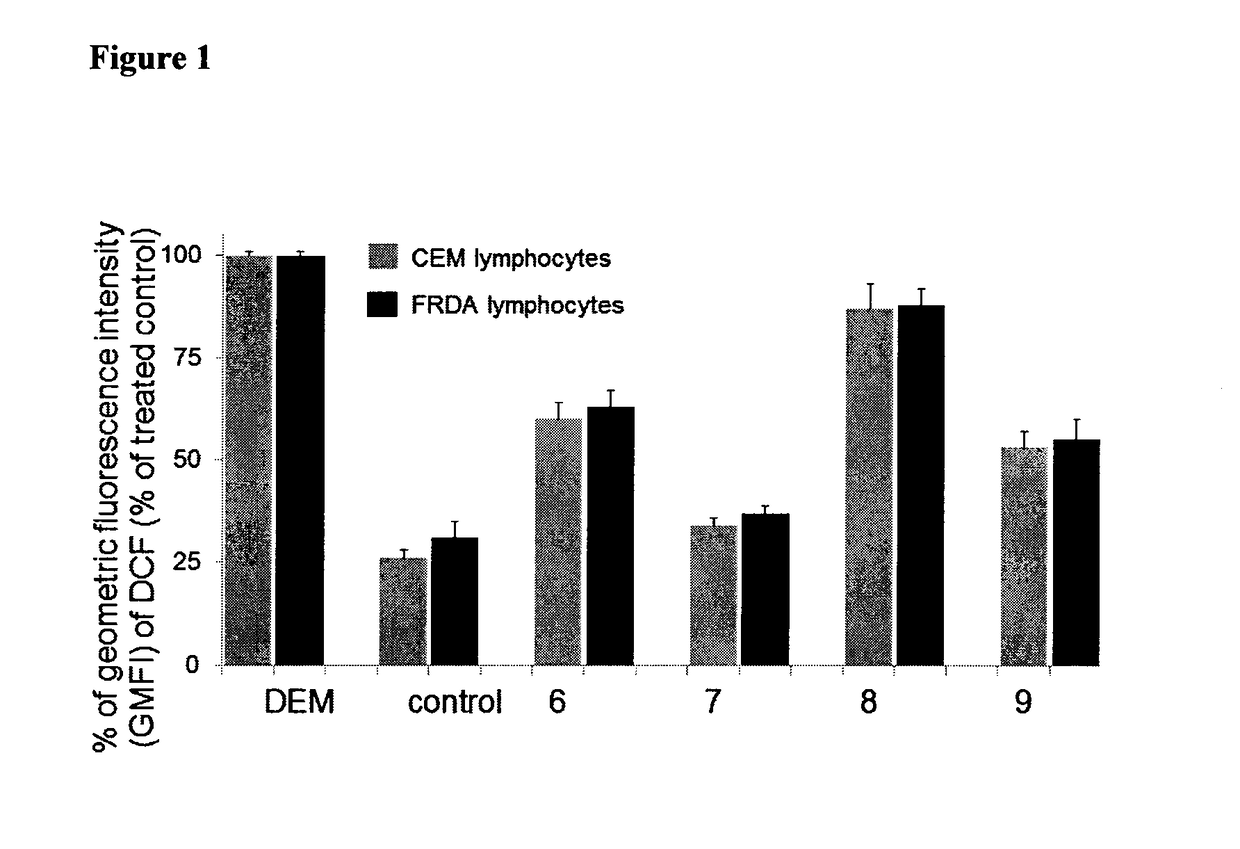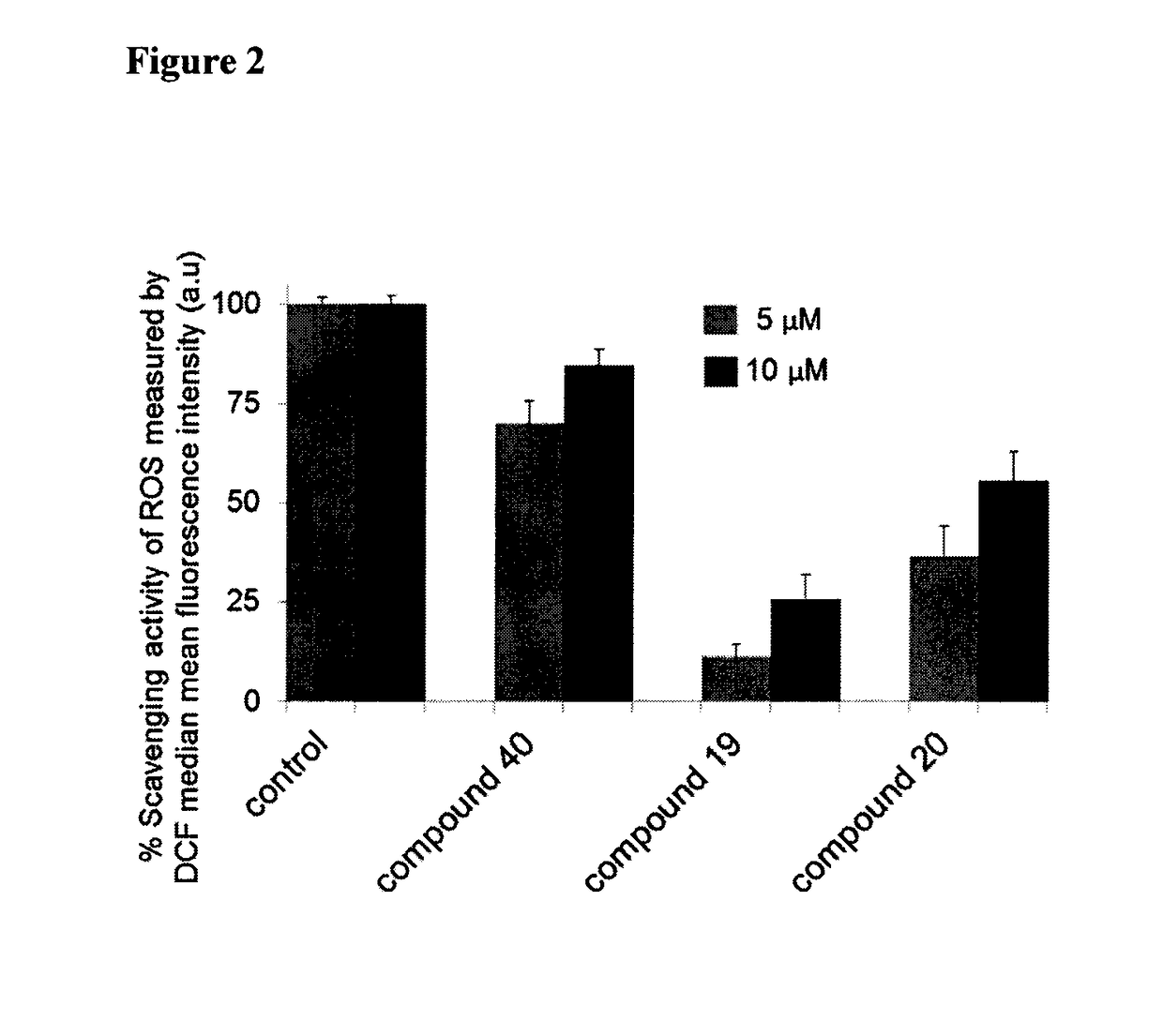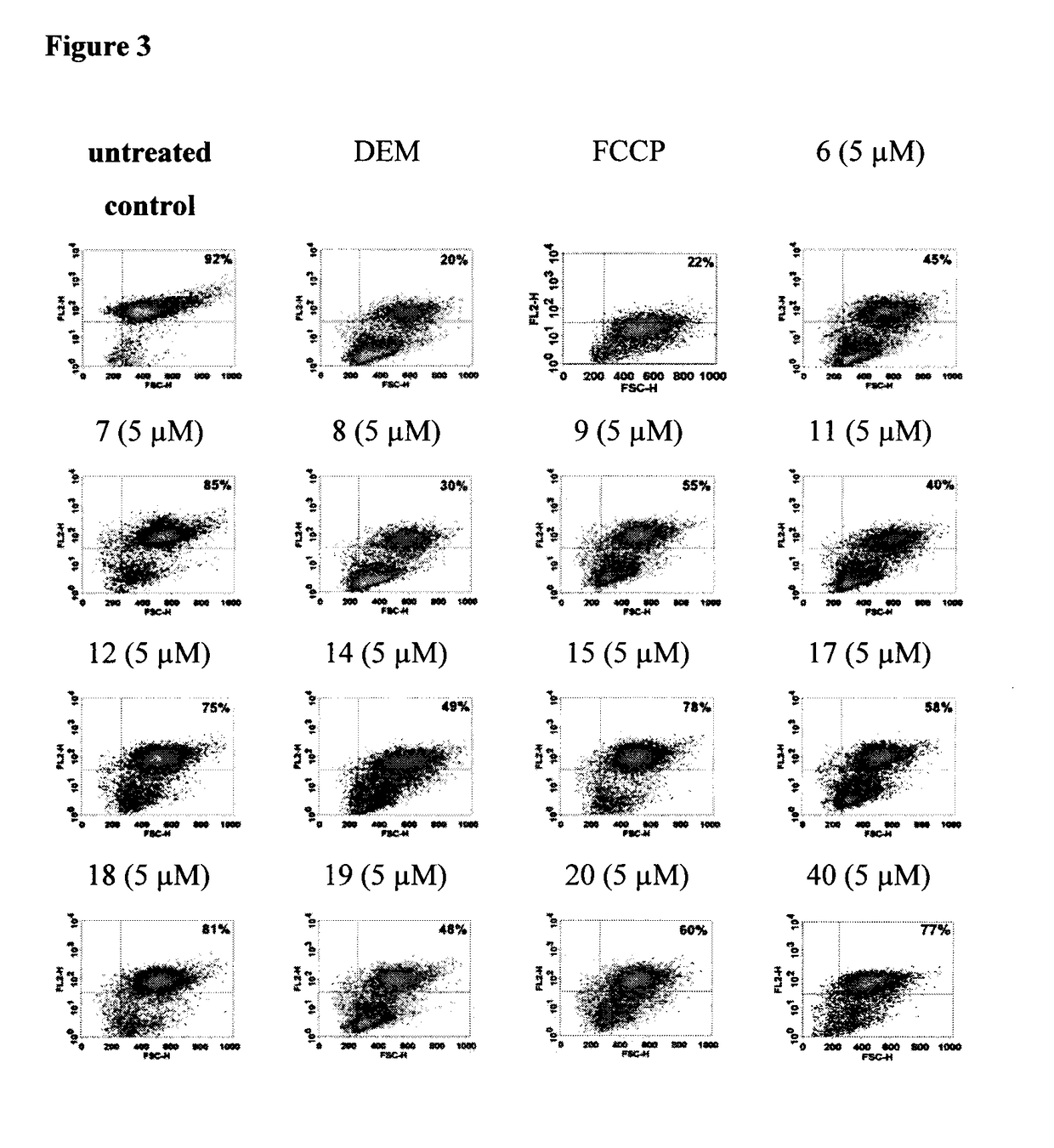Multifunctional radical quenchers
a multi-functional, radical quenching technology, applied in the direction of anti-noxious agents, extracellular fluid disorders, metabolic disorders, etc., can solve the problems of high energy level demands of neural and muscle tissues, damage to mitochondria, etc., to prevent the production of reactive oxygen species (ros), increase the concentration of atp, and inhibit the effect of lipid peroxidation
- Summary
- Abstract
- Description
- Claims
- Application Information
AI Technical Summary
Benefits of technology
Problems solved by technology
Method used
Image
Examples
example 1
on of 2-hydroxy-5-methoxy-3-tridecylcyclohexa-2,5-diene-1,4-dione (5)
[0163]
[0164]To a solution containing 10 g (51.0 mmol) of 2,4,5-trimethoxybenzaldehyde and 6.4 mL of H2O2 (35% wt solution in H2O) in 102 mL of methanol was added 1.02 mL (18.4 mmol) of concentrated H2SO4 dropwise under an atmosphere of argon at room temperature. The reaction mixture was heated to reflux for 2 h, diluted with water and extracted with three 100 mL portions of dichloromethane. The combined organic layer was washed with brine, dried (MgSO4) and concentrated under diminished pressure. The crude residue was applied to a silica gel column (12×4 cm). Step gradient elution with 1:4-1:2 ethyl acetate-hexanes afforded 1 as a yellow solid: yield 7.34 g (78%); silica gel TLC Rf 0.45 (1:1 ethyl acetate-hexanes); 1H NMR (CDCl3) δ 3.48 (s, 6H), 3.52 (s, 3H), 6.08 (br.s, 1H), 6.33 (s, 1H), 6.36 (s, 1H); 13C NMR (CDCl3) δ 56.4, 57.0, 57.2, 99.6, 100.9, 139.6, 142.1 and 143.8.
b. 1,2,4,5-tetramethoxybenzene (2)
[0165]
[...
example 2
on of tert-butyl 4-(4-hydroxy-3,6-dioxo-5-tridecylcyclohexa-1,4-dienylamino)butanoate (6)
[0171]
[0172]To a solution of 42 mg (0.13 mmol) of 2-hydroxy-5-methoxy-3-tridecyl-(1,4)-benzoquinone (5) and 1.0 g (13 mmol) of sodium bicarbonate in 9.7 mL of ethanol was added 39 mg (0.19 mmol) of γ-aminobutyric acid tert-butyl ester hydrochloride salt. The reaction mixture was stirred for 27 h at 45° C. under an atmosphere of argon. The reaction mixture was then diluted with 5 mL of water and extracted with seven 2 mL portions of dichloromethane. The organic layer was washed with water, brine and dried (Na2SO4). The excess solvent was concentrated under diminished pressure to afford a crude residue. The crude residue was applied to a silica gel column (5×2 cm). Elution with dichloromethane gave 6 as a dark red solid: yield 27 mg (45%); mp 96-97° C.; silica gel TLC Rf 0.38 (dichloromethane); 1H NMR (CDCl3) δ 0.86 (314, t, J=6.5 Hz), 1.20-1.32 (20H, m), 1.38-1.46 (11H, m), 1.94 (2H, quin, J=6.9 ...
example 3
on of tert-butyl 4-(4-methoxy-3,6-dioxo-5-tridecylcyclohexa-1,4-dienylamino)butanoate (7)
[0173]
[0174]To a solution containing 22 mg (0.047 mmol) of 6 and 0.25 g (1.8 mmol) of potassium carbonate in 1.2 mL of dry acetone was added 23 μL (0.23 mmol) of dimethyl sulfate. The reaction mixture was heated to reflux overnight, cooled to room temperature and concentrated under diminished pressure. The crude mixture was redissolved in 10 mL of dichloromethane, washed with 5 mL of 1N HCl and the aq layer extracted with three 10 mL portions of dichloromethane. The combined organic layer was dried (MgSO4) and concentrated under diminished pressure. The residue was purified by flash column chromatography on a silica gel column (24×2 cm). Elution with 1:5 ethyl acetate-hexane gave 7 as a bright red amorphous solid: yield 21 mg (91%); silica gel TLC Rf 0.60 (1:2 ethyl acetate-hexanes); 1H NMR (CDCl3) δ 0.87 (3H, t, J=6.8 Hz), 1.16-1.42 (22H, m), 1.45 (9H, s), 1.82-2.03 (2H, quin, J=9 Hz), 2.31 (2H...
PUM
| Property | Measurement | Unit |
|---|---|---|
| temperature | aaaaa | aaaaa |
| temperature | aaaaa | aaaaa |
| temperature | aaaaa | aaaaa |
Abstract
Description
Claims
Application Information
 Login to View More
Login to View More - R&D
- Intellectual Property
- Life Sciences
- Materials
- Tech Scout
- Unparalleled Data Quality
- Higher Quality Content
- 60% Fewer Hallucinations
Browse by: Latest US Patents, China's latest patents, Technical Efficacy Thesaurus, Application Domain, Technology Topic, Popular Technical Reports.
© 2025 PatSnap. All rights reserved.Legal|Privacy policy|Modern Slavery Act Transparency Statement|Sitemap|About US| Contact US: help@patsnap.com



